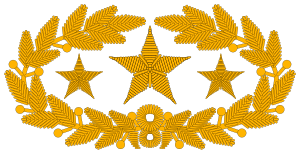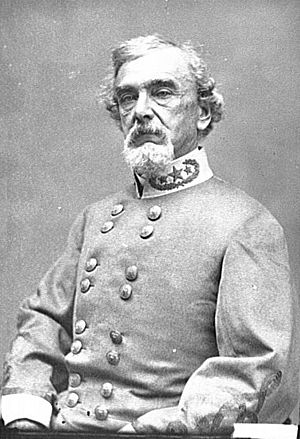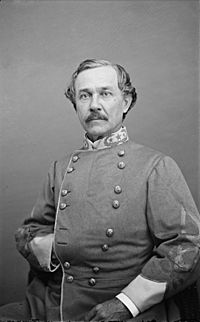General officers in the Confederate States Army facts for kids
The general officers of the Confederate States Army (CSA) were the top military leaders of the Confederacy during the American Civil War (1861–1865). Many of these generals were once officers in the United States Army before the war began. Others earned their rank through skill or when the army needed them. Most Confederate generals had to be approved by the Confederate Congress.
Like all Confederate military forces, these generals reported to their civilian leaders. Their main leader was Jefferson Davis, the South's president and the Commander-in-Chief of the Army, Navy, and Marines.
Contents
Confederate Army's Beginning
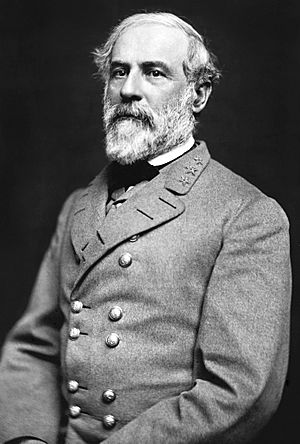
The Confederate States Army was designed much like the U.S. Army. The Confederate Congress created their War Department on February 21, 1861. The Confederate Army had three main parts:
- The Army of the Confederate States of America (ACSA), which was meant to be the permanent, regular army.
- The Provisional Army of the Confederate States (PACS), a volunteer army that would be disbanded after the war.
- Various state militias from the Southern United States.
President Jefferson Davis especially wanted graduates from West Point and veterans of the Mexican–American War to serve as general officers. Just like the Union Army, the Confederate Army had both professional soldiers and "political generals" (leaders who got their rank due to political connections).
On February 27, 1861, a general staff was approved for the army. This staff included key roles like an adjutant general (who managed records and orders) and a quartermaster general (who handled supplies). Samuel Cooper served as the adjutant general throughout the war.
At first, the Confederate Army only had brigadier generals. But soon, Congress allowed for major generals and generals to be appointed. This helped make sure there was a clear ranking system. By September 18, 1862, the Confederate Army had four ranks of general officers: brigadier general, major general, lieutenant general, and general. President Davis created the promotion lists and decided the seniority of officers.
Brigadier General Role

Brigadier generals usually commanded infantry or cavalry brigades. A brigade is a large group of soldiers, made up of several regiments. They also served as aides to higher-ranking generals or worked in the War Department.
By the end of the war, at least 383 different men held this rank in the volunteer army (PACS). Only three were brigadier generals in the regular army (ACSA): Samuel Cooper, Robert E. Lee, and Joseph E. Johnston.
Confederate brigadiers mainly led brigades. Union brigadiers, however, sometimes led larger groups called divisions. These generals were nominated by President Davis and approved by the Confederate Senate. They outranked colonels, who usually led regiments. This rank is similar to a brigadier general in today's U.S. Army.
Major General Role
Major generals most often commanded divisions of infantry. A division is a military unit larger than a brigade. They also served as aides to higher-ranking generals or worked in the War Department. Some major generals even led smaller military departments.
By the end of the war, at least 88 different men held this rank, all in the volunteer army (PACS). Divisions were approved by Congress on March 6, 1861. Major generals were nominated by President Davis and confirmed by the Senate. They outranked brigadier generals and all other lower officers.
This rank was used differently than in the Union Army. Union major generals led divisions, corps (even larger units), and sometimes entire armies. The Confederate major general rank is similar to a major general in today's U.S. Army.
Lieutenant General Role

There were 18 lieutenant generals in the Confederate Army. These generals often commanded corps within armies or led entire military departments. A corps is a very large military unit, made up of several divisions. All Confederate lieutenant generals were in the volunteer army (PACS).
The Confederate Congress allowed for the creation of army corps on September 18, 1862, and said that lieutenant generals should lead them. These generals were nominated by President Davis and confirmed by the Senate. Lieutenant generals outranked major generals and all other lower officers.
This rank was also used differently than in the Union Army. Ulysses S. Grant was one of only two Union lieutenant generals during the war. The other was Winfield Scott, who was General-in-Chief of the U.S. Army before the war. Grant became the commander of all Union armies, reporting directly to President Abraham Lincoln. The CSA lieutenant general rank is similar to a lieutenant general in today's U.S. Army.
Sometimes, "temporary" general officers were appointed to fill open positions. For example, Richard H. Anderson and Jubal Early were temporarily appointed as lieutenant generals to command corps. They returned to their major general rank when their temporary assignments ended.
General Role
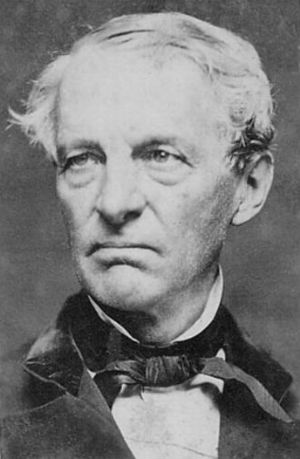
Initially, five officers in the South were appointed to the rank of general, and only two more were added later. These generals held the highest positions in the Confederate Army. They often commanded entire armies or military departments, and they advised President Jefferson Davis. This rank is similar to a general in today's U.S. Army. It's often called "full general" to show it's the highest general rank.
All Confederate generals were part of the regular army (ACSA) to ensure they outranked all militia officers. The first five generals were Samuel Cooper, Albert Sidney Johnston, Robert E. Lee, Joseph E. Johnston, and Pierre G.T. Beauregard. Cooper was the most senior, even though he was a staff officer and didn't see combat. This caused some tension, especially with Joseph E. Johnston, who felt he should have been the most senior.
Later, Edmund Kirby Smith was appointed a general to command the Trans-Mississippi Department in the Far West. Braxton Bragg was also appointed a general after his commanding officer, Albert Sidney Johnston, died in battle.
Sometimes, "temporary" generals were appointed. John Bell Hood was a "temporary" general when he took command of the Army of Tennessee. However, his appointment was not confirmed by Congress, so he returned to his lieutenant general rank.
General in Chief
The position of General in Chief of the Armies of the Confederate States was created on January 23, 1865. The only officer to hold this top position was Gen. Robert E. Lee. He served from February 6 until April 12, near the end of the war.
Militia Generals
The Southern states had their own militias, which were like local armies, since the American Revolutionary War. These militias were called by different names, such as State "Militia" or "Guard." They were activated and grew when the Civil War began.
These units were led by "Militia Generals." Their job was to defend their specific state. Sometimes, they did not leave their home state to fight for the Confederacy. Confederate militias used the general officer ranks of brigadier general and major general.
Uniform Insignia
All Confederate generals wore similar uniform insignia, no matter their rank. The only main difference was the number of buttons on their uniforms. Lieutenant and major generals had groups of three buttons, while brigadier generals had groups of two. Generals' buttons also had an eagle design, different from other ranks.
| Rank | Collar insignia | Sleeve insignia | Buttons |
|---|---|---|---|
| General |  (all grades) |
 (all grades) |
|
| Lieutenant General | Groups of three buttons | ||
| Major General | Groups of three buttons | ||
| Brigadier General | Groups of two buttons |
General Joseph Reid Anderson is shown in a CSA brigadier general's uniform. All Southern generals wore uniforms like this, with gold-colored embroidery.
Pay for Generals
Confederate Army general officers were paid for their service in Confederate dollars (CSD). Their pay depended on their rank and whether they commanded troops in the field.
On March 6, 1861, brigadier generals were paid $301 CSD per month. By June 10, 1864, a full general received $500 CSD monthly, plus another $500 CSD if they commanded an army in the field. Lieutenant generals earned $450 CSD, and major generals received $350 CSD. Brigadier generals received an extra $50 CSD if they served in combat.
Legacy of Confederate Generals
The Confederate Army lost more general officers killed in combat than the Union Army did. The South lost about five generals for every one lost by the North. One of the most famous fallen generals was General Thomas "Stonewall" Jackson. He was probably the best-known Confederate commander after General Robert E. Lee. Jackson died from pneumonia after being accidentally shot by his own troops at the Battle of Chancellorsville on May 2, 1863.
Replacing these fallen generals was a constant challenge during the war. Sometimes, men were promoted beyond their true abilities, which was a problem for both armies. The South also faced a shrinking number of available soldiers, especially near the end of the war.
The last Confederate general in the field, Stand Watie, surrendered on June 23, 1865. The war's last surviving full general, Edmund Kirby Smith, died on March 28, 1893. James Longstreet died on January 2, 1904, and was considered "the last of the high command of the Confederacy."
The Confederate Army's system of using four ranks of general officers is similar to the rank structure used by the U.S. Army today. It is also the system used by the United States Marine Corps.


